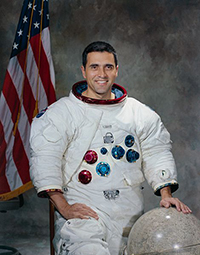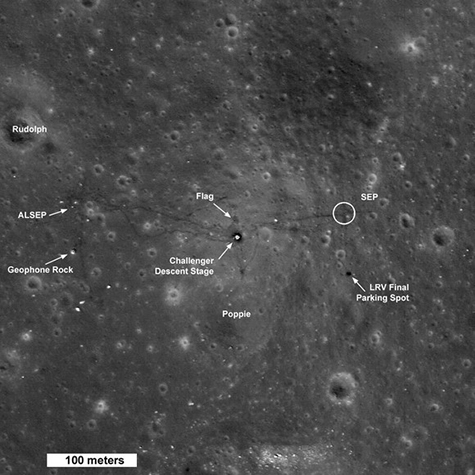
(Credit: NASA)
Harrison “Jack” Schmitt, a geologist and Apollo 17 astronaut, will be visiting Washington University in St. Louis for a week of activities centered on lunar exploration.
On Monday, May 20, Schmitt will give a seminar titled “Field Geology on Another World: Perspectives From the Taurus-Littrow Valley, Moon.” The talk, which beings at 2 p.m. in Room 201 Crow Hall, is free and open to the public.
Schmitt was on board the last Apollo mission to the moon, Apollo 17, which left Earth Dec. 7, 1972, to land near the southeastern edge of Mare Serenitatis in the Valley of Taurus-Littrow.
Schmitt writes: “For 75 hours, Gene Cernan and I lived and worked in the valley, performing extensive geological studies of the volcanic rocks that partially fill the valley, the boulders that rolled into the valley from the surrounding mountains, and the meteor impact generated soils that cover the valley floor and walls.
“Successful exploration of Taurus-Littrow capped a six-mission investigation of the materials and history of the moon. At the conclusion of these studies, science had gained a first order understanding of the evolution of the moon as a planet.”
Exploration forum with students
After the seminar, Schmitt then will participate in an “exploration forum,” an informal gathering of students to discuss the future of human space exploration, especially what should or could be done differently next time there is a manned mission to the moon. Students from earth and planetary sciences and physics in Arts & Sciences will participate, as will the WUSTL RASC-AL team.
The RASC-AL team is a group of WUSTL undergraduate and graduate students who entered a NASA-sponsored competition called Revolutionary Aerospace Systems Concepts-Academic Linkage (RASC-AL) this year. In this competition, students are asked to develop concepts that may provide solutions to design challenges human space exploration currently faces.
The WUSTL team proposed investigating potential landing sites for a lunar outpost at the moon’s South Pole, from which astronauts could test areas in permanent shadow for volatile compounds that would not have survived exposure to sunlight elsewhere on the moon. The evidence of these volatiles and the geological characterization of this unexplored moon region might answer longstanding questions about the moon and its origins.
The team has reached the competition’s second round and will travel to Cocoa Beach, Fla., in June to present its proposal to a panel of NASA, Boeing and other industry judges. The exploration forum will give the team a chance to rehearse aspects of the presentation it will later make at the RASC-AL forum.
An eclectic mix of students in engineering, business administration, earth and planetary science, environmental earth science and medicine, the RASC-AL team is advised by Ramesh Agarwal, PhD, the William Palm Professor of Engineering mechanical engineering in the School of Engineering & Applied Science.
Review meeting
Tuesday through Thursday, Schmitt will participate in a science team meeting for the Lunar Reconnaissance Orbiter Cameras (LROC), hosted by Brad Jolliff, PhD, the Scott Rudolph Professor of Earth and Planetary Sciences in Arts & Sciences.

The Lunar Reconnaissance Orbiter is a spacecraft launched in 2009 that is currently orbiting the moon in a low orbit that passes over the poles. Its purpose is to prepare for future missions to the moon by making detailed maps of its surface that can be used to identify safe landing sites and potential resources and characterize the radiation environment.
The LRO camera’s principal investigator is Mark Robinson, PhD, professor of earth and space exploration at Arizona State University. The LROC team includes distinguished space scientists from U.S. universities, the Smithsonian Institution and the University of Münster in Germany.
At the meeting, the team will discuss spacecraft and camera operations, spacecraft observations (volcanic, tectonic and impact features), future operations, future targets and image processing.